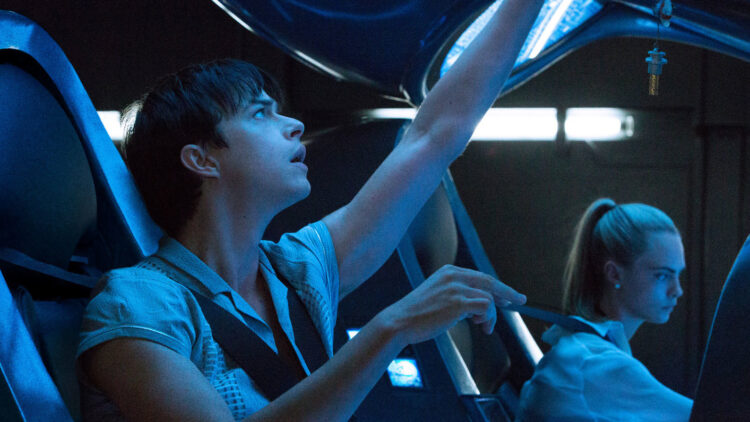The City of a Thousand Planets: A Movie Lover’s Guide

In the 28th century, Agents Valerian (Dane DeHaan) and Laureline (Cara Delevingne) maintain order in the human territories.
“The City of a Thousand Planets,” officially titled Valerian and the City of a Thousand Planets, is a 2017 science fiction film directed by Luc Besson. Based on the French science fiction comics series Valérian and Laureline by Pierre Christin and Jean-Claude Mézières, the film transports viewers to an imaginative and visually stunning universe. This guide explores the film’s plot, characters, visual aesthetics, production details, and its reception, offering movie lovers a comprehensive understanding of this cinematic spectacle.
Plot Summary
Set in the 28th century, Valerian and the City of a Thousand Planets follows the adventures of Major Valerian (Dane DeHaan) and Sergeant Laureline (Cara Delevingne), special operatives tasked with maintaining order in the universe. The story begins with a breathtaking montage showing the evolution of Alpha, the titular “City of a Thousand Planets.” Alpha is a massive space station that has grown over centuries, incorporating the knowledge and cultures of a multitude of alien species.
Valerian and Laureline are sent on a mission to retrieve a unique converter creature from a dangerous black market. This creature, known as a “Mül Converter,” can replicate anything it eats, making it incredibly valuable. The mission takes them to the exotic Big Market, a multi-dimensional shopping center where customers can interact with items in different dimensions.
Their successful retrieval of the converter sets off a chain of events that leads them to uncover a dark secret at the heart of Alpha. They discover that a mysterious force is threatening the city’s peaceful existence, emanating from a hidden area known as the Dead Zone. As Valerian and Laureline delve deeper, they uncover a conspiracy involving the destruction of the peaceful planet Mül and the displacement of its inhabitants. Their quest becomes a race against time to save Alpha and bring justice to the wronged.
Characters
Valerian
Major Valerian is a cocky and skilled agent who excels in combat and strategy. Despite his bravado, he has a deep sense of duty and justice. Valerian’s character arc involves his struggle with personal commitment, particularly his romantic feelings for his partner, Laureline. Dane DeHaan’s portrayal of Valerian captures the character’s youthful arrogance and underlying vulnerability.
Laureline
Sergeant Laureline is Valerian’s partner and equal in every sense. She is intelligent, resourceful, and unafraid to challenge Valerian’s authority. Laureline’s character provides a strong counterbalance to Valerian’s impulsiveness, and her quick thinking often saves them from perilous situations. Cara Delevingne brings a blend of toughness and charm to the role, making Laureline a standout character.
Commander Arün Filitt
Commander Arün Filitt, played by Clive Owen, is the head of Alpha’s defense forces. His character is shrouded in mystery and plays a central role in the film’s conflict. Filitt’s hidden agenda and past actions drive much of the plot’s tension and revelations.
Supporting Characters
The film features a diverse array of supporting characters, including alien species and human allies. Notable mentions include Rihanna as Bubble, an entertainer who aids Valerian and Laureline, and Ethan Hawke as Jolly the Pimp, who provides comic relief. The inhabitants of Mül, particularly their leader, Emperor Haban Limaï (voiced by Elizabeth Debicki), add emotional depth to the narrative.
Visual Aesthetics and World-Building
One of the most striking aspects of Valerian and the City of a Thousand Planets is its visual aesthetics. Luc Besson, known for his work on The Fifth Element, brings his visionary style to create a universe that is both fantastical and immersive.
Alpha: The City of a Thousand Planets
Alpha is a character in itself, a sprawling metropolis in space that houses millions of beings from thousands of planets. The city’s design is a testament to the creativity and attention to detail that went into the film’s production. Each section of Alpha is unique, reflecting the cultures and technologies of its inhabitants. From the serene underwater world of the aquatic species to the bustling markets of the human sectors, Alpha is a vibrant and dynamic setting.
Creature and Character Design
The film’s creature and character design draw heavily from the original comics, with updates to fit a modern cinematic context. The Mül Converter, for instance, is a cute yet pivotal creature whose design balances whimsy and function. The diverse alien species are brought to life with a combination of practical effects, prosthetics, and cutting-edge CGI. The Pearl people from Mül, with their ethereal beauty and bioluminescent skin, stand out as one of the most visually captivating species.
Special Effects
The special effects in Valerian and the City of a Thousand Planets are a major highlight. The film uses state-of-the-art CGI to create seamless interactions between actors and their fantastical environments. The action sequences, particularly those set in zero-gravity or multi-dimensional spaces, are executed with precision and creativity. The attention to detail in these scenes enhances the sense of immersion and spectacle.
Production Details
Development
The journey to bring Valerian and the City of a Thousand Planets to the big screen was a long and challenging one. Luc Besson had been a fan of the Valérian and Laureline comics since his childhood and had dreamed of adapting them into a film for years. The success of Avatar in 2009, with its groundbreaking visual effects, convinced Besson that technology had finally caught up to his vision.
Casting
Casting for the film brought together a mix of established actors and rising stars. Dane DeHaan and Cara Delevingne were chosen for their chemistry and ability to bring depth to their characters. The supporting cast, including Clive Owen, Rihanna, and Ethan Hawke, added star power and brought their unique talents to the film.
Filming
Principal photography for the film began in January 2016 and took place primarily at the Cité du Cinéma in Saint-Denis, France. The production utilized an array of sets and extensive green screen work to create the film’s otherworldly environments. Besson’s meticulous attention to detail ensured that every element of the film’s universe felt authentic and lived-in.
Music
The film’s score, composed by Alexandre Desplat, complements the visual spectacle with a rich and dynamic soundtrack. Desplat’s music ranges from sweeping orchestral themes to more intimate and emotional pieces, enhancing the film’s narrative and emotional impact. The inclusion of popular songs, such as David Bowie’s “Space Oddity,” adds a contemporary touch to the film’s eclectic soundtrack.
Reception and Legacy
Critical Reception
Valerian and the City of a Thousand Planets received mixed reviews from critics. While the film’s visual effects and imaginative world-building were universally praised, opinions on the story and character development were more divided. Some critics felt that the film’s plot was convoluted and lacked coherence, while others appreciated its ambition and originality. The performances of Dane DeHaan and Cara Delevingne also garnered mixed reactions, with some praising their chemistry and others finding their portrayals lacking depth.
Box Office Performance
Despite its high production costs, Valerian and the City of a Thousand Planets underperformed at the box office. The film faced stiff competition from other summer blockbusters and struggled to find a broad audience. However, it found a more appreciative audience in international markets, particularly in France, where the original comics are well-known and beloved.
Cult Following
Over time, Valerian and the City of a Thousand Planets has gained a cult following among sci-fi enthusiasts and fans of Luc Besson’s work. The film’s unique visual style and imaginative world continue to captivate viewers, and it has found a new life on streaming platforms and home video. For many, the film represents a bold and ambitious attempt to bring a beloved comic series to the big screen.
Conclusion
Valerian and the City of a Thousand Planets is a visually stunning and ambitious film that pushes the boundaries of science fiction cinema. Despite its mixed reception and box office challenges, the film’s imaginative world-building, compelling characters, and groundbreaking special effects make it a must-watch for movie lovers. Luc Besson’s passion project may not have achieved the mainstream success he envisioned, but it stands as a testament to the power of creativity and the enduring appeal of the Valérian and Laureline universe. For those willing to dive into its fantastical world, Valerian and the City of a Thousand Planets offers a unique and unforgettable cinematic experience.

